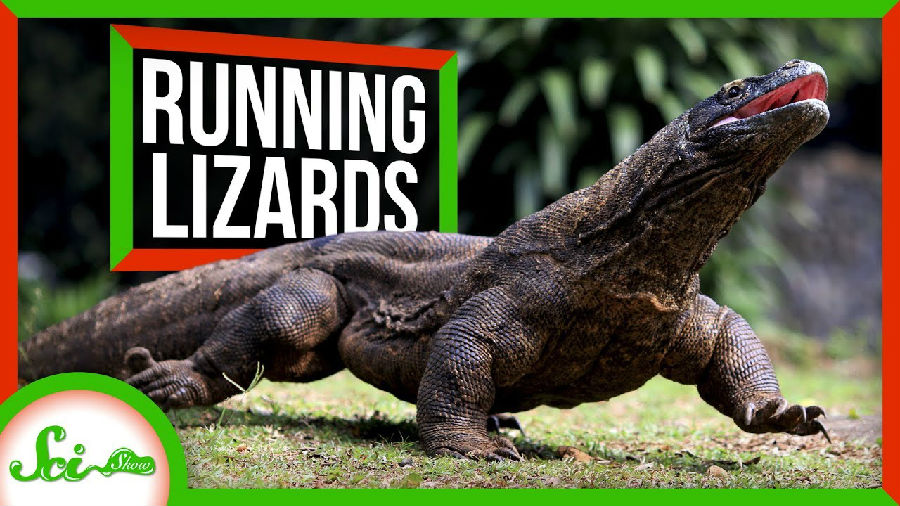If you've ever seen a lizard move, you may have noticed that it runs, then stops for a bit, then runs again.
如果你曾经见过蜥蜴移动,你或许注意到了蜥蜴会跑一下停一下,然后再跑。
Well, it turns out that lizards—some of them, anyway—can't run and breathe at the same time.
事实上,一些蜥蜴不能同时跑和呼吸。
And this seems to be an evolutionary leftover from the time before the ancestors of four-legged creatures adapted to life on land
这似乎是四足动物的祖先适应陆地生活之前的进化残余
—one that different groups of animals have found different ways to get around.
不同的动物群体找到了不同的逃避这一进化残余。
For a lizard, running and breathing require the same muscles.
对蜥蜴而言,跑和呼吸需要相同的肌肉。
To run, a lizard has to contract its chest muscles one after the other to help it scamper forward.
要奔跑,蜥蜴就必须一个接一个地收缩它的胸肌来帮助它向前跳跃。
And to breathe, it has to contract those same muscles in different ways. And it can't do both at once.
要呼吸,蜥蜴即必须以不同的方式收缩相同的肌肉。并且它不能同时做这两件事。
In a 1997 study published in The Journal of Experimental Biology, scientists put iguanas on treadmills.
在1997年发表于《实验生物学期刊》的一项研究中,科学家把鬣蜥放在跑步机上。
And they found that the faster the iguanas ran, the harder it was for them to breathe, which doesn't make a lot of sense.
他们发现鬣蜥跑得越快,呼吸就越困难,这并不合逻辑。
If you're fleeing or chasing down prey, wouldn't you need to keep breathing so you can keep running?
如果正在逃跑或追赶猎物,难道你不需要保持呼吸来奔跑吗?
Well, a 1987 paper in Paleobiology suggested that this flaw in lizards' body plan
1987年发表于《古生物学》的一篇论文表明蜥蜴身体内的这种缺陷
is an evolutionary holdover from when some vertebrates transitioned from living in the sea to living on land.
是一些脊椎动物从海里生活过渡到陆地生活中的进化延期。
The paper said that early tetrapods—a group that today includes four-limbed reptiles, amphibians, birds, and mammals—
论文称早期的四足动物—如今包括四肢爬行动物、两栖动物、鸟类和哺乳动物—
may have evolved from fish that lived in oxygen-poor waters and were only able to swim in short, rapid bursts.
可能是由生活在缺氧水域的鱼类进化而来,它们只能在短时间内快速游动。
Sort of like how modern lizards move. And while those fish could breathe pretty well in water,
有点像现代蜥蜴的移动方式。虽然那些鱼可以在水中顺畅呼吸,

that wasn't quite the case for their descendants adapting to life on land—despite having a similar way of moving.
但对于它们已经适应了陆地生活的后代而言却并非如此—尽管它们有着相似的移动方式。
It turns out that walking on land takes up a whole lot more energy than swimming does.
结果证明行走在陆地上比在水中游走更需要精力。
Also, that limitation of not being able to run while breathing
同样,呼吸时不能奔跑的限制
may have forced these early ancestors to rely more on intense but tiring bursts of movement.
可能迫使这些早期祖先更多地依赖于剧烈但令人疲惫的移动。
But lizards have adapted to handle this as best they can.
但蜥蜴已经尽可能的适应了处理这个缺陷。
Even if they have to stop and catch their breath, when they do move they can scurry around really fast,
即便它们需要停下来歇口气,但当它们移动的时候,它们可以非常快地跑来跑去,
which may help them maximize what they can get out of a muscle configuration that limits their oxygen.
这或许帮助它们最大限度地利用限制氧气的肌肉结构。
Other lizards have also evolved better ways of breathing while running.
其他种类的蜥蜴也进化出了奔跑时呼吸的更好方式。
For example, monitor lizards don't seem to have a problem breathing while running, even when they're running at a decent clip.
例如,巨蜥似乎没有奔跑呼吸困难的问题,即使是在它们迅速奔跑时也没有。
A 1999 study published in Science found that this ability may be due to gular pumping.
1999年发表于《科学》的一项研究发现这种能力或许源于咽喉输送。
That is, monitor lizards and some other lizard species as well can expand and contract their throat to pump more fresh air into their lungs.
巨蜥和一些其他种类的蜥蜴可以扩张和收缩它们的咽喉以向肺部输送更多新鲜空气。
The scientists in the study showed that when monitor lizards were experimentally prevented from doing this throat pumping,
参与该研究的科学家表示,当在实验中阻止巨蜥进行这种咽喉输送时,
they breathed similarly to lizards that don't have that evolutionary advantage.
它们的呼吸方式和那些没有进化优势的蜥蜴类似。
And these sorts of adaptations aren't just limited to lizards.
这种适应性不仅限于蜥蜴。
Most tetrapods have developed ways of breathing more effectively on land.
大部分四足动物已经进化出了在陆地上呼吸的更有效方式。
The diaphragm muscle in mammals, for example, pushes air in and out of our lungs. Crocodiles have these as well.
例如哺乳动物体内的膈肌将空气从它们的肺部呼入呼出。鳄鱼也有。
And over time, birds changed their locomotor posture, or the way they position their body while moving around,
随时间推,鸟类改变了它们的移动姿势或者移动时的身体姿势,
so that they didn't need to use the same muscles for breathing and moving.
这样它们就不需要用同样的肌肉来呼吸和运动。
Finally, horses and some other animals that can trot or run, like guinea fowl, breathe in a rhythm that coincides with their movements.
最后,马和一些其他能小跑或奔跑的动物,如珍珠鸡,它们呼吸的节奏与它们的移动一致。
This motion helps them move air in and out of their system more effectively.
这种移动帮助它们更有效地将空气送进送出它们的体内。
So while lizards' start-and-stop running pattern may seem like an evolutionary problem, it's actually a side effect of evolutionary innovation.
所以虽然蜥蜴的启动和停止奔跑模式可能是一个进化问题,但其实也是演化革新的一个副作用。
Since then, animals have adapted through changes in their anatomy, behavior, and overall
自那以后,动物通过骨骼、行为等改变
just making the best, most efficient use of the bodies that they have.
尽可能最高效地利用它们的身体以适应环境。
Thanks for watching this episode of SciShow, and thanks to our patrons for supporting us.
感谢收看本期《科学秀》,感谢赞助人的支持。
Patrons can submit their weird science questions to our QQ inbox and some of them get made into episodes like this one,
赞助人可以向我们其提出奇怪的问题,其中一些问题还可能被制作成像这样的节目,
so head over to patreon.com/scishow and ask away.
赶快前往
patreon.
com/
scishow进行提问吧。


